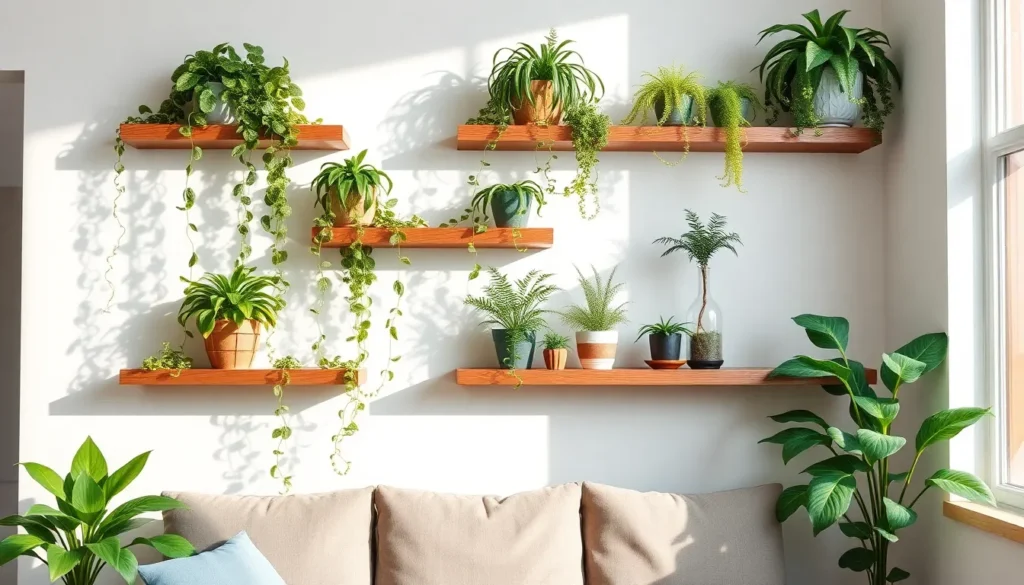Transform your living space into a green oasis with the perfect combination of floating shelves and plants. We’ve discovered that this design trend isn’t just about aesthetics – it’s a game-changer for small spaces and plant lovers who want to maximize their vertical growing potential.
Floating shelves create the illusion of plants suspended in mid-air while providing crucial display space that doesn’t eat up your floor area. Whether you’re dealing with a tiny apartment or simply want to add layers of greenery to any room we’ll show you how this versatile solution works in every space from bathrooms to bedrooms.
The best part? You don’t need to be a DIY expert or have a green thumb to pull this off successfully. We’ve tested countless combinations and found the perfect plant-and-shelf pairings that’ll make your walls come alive while keeping maintenance simple and stress-free.
Choose the Right Floating Shelves for Your Plant Display
Selecting the perfect floating shelves for your plant display requires careful consideration of several key factors. We’ll guide you through the essential elements that ensure your shelves can safely support your green companions while improving your space’s aesthetic appeal.
Weight Capacity Considerations
Check the weight rating before purchasing any floating shelf for plant displays. Most standard floating shelves support between 15-40 pounds, but plants with soil and decorative pots can quickly exceed these limits. We recommend calculating the total weight of your heaviest plant, including the pot, soil, and water, then choosing shelves rated for at least 20% more than this amount.
Heavy ceramic planters and large plants require industrial-grade brackets. These specialized mounting systems can support 50-100 pounds per shelf, making them ideal for statement plants like fiddle leaf figs or large snake plants. Professional installation becomes essential when dealing with these heavier loads.
Test your wall’s structural integrity before installation. Drywall anchors work well for lighter plants under 10 pounds, while heavier displays need wall studs or toggle bolts for secure mounting. We’ve found that marking stud locations first prevents costly mistakes and ensures long-term stability.
Material Options for Plant-Friendly Shelves
Wood shelves offer natural beauty but require moisture protection for plant displays. Sealed hardwoods like oak and maple resist water damage better than softwoods, while bamboo provides an eco-friendly option that naturally resists moisture. We recommend applying a waterproof sealant annually to maintain wood shelves in plant-heavy environments.
Metal floating shelves provide superior durability and weight capacity. Stainless steel and powder-coated aluminum resist rust and corrosion from plant watering, making them perfect for bathroom or kitchen herb gardens. These materials also complement modern and industrial design styles beautifully.
Glass shelves create an airy, minimalist look but have weight limitations. Tempered glass can safely hold smaller plants up to 20 pounds while allowing light to reach plants on lower shelves. We suggest using glass shelves for succulents, air plants, and lightweight ceramic pots.
Size and Spacing Requirements
Measure your plants’ mature sizes before determining shelf dimensions. Most houseplants need 12-18 inches of horizontal space and 8-12 inches of vertical clearance for healthy growth. We recommend adding 2-3 inches of extra space around each plant to accommodate future growth and easy maintenance access.
Plan vertical spacing based on your tallest plants and lighting needs. Shelves should be positioned 16-24 inches apart to prevent upper plants from blocking light to lower ones. Trailing plants like pothos and ivy need additional clearance of 12-18 inches below their shelves.
Consider depth requirements for different plant types. Standard 8-inch deep shelves work well for small succulents and herbs, while larger plants need 10-12 inch depths. We’ve found that deeper shelves also provide better visual balance and prevent plants from appearing to hang over the edge.
Select the Perfect Plants for Floating Shelf Gardens
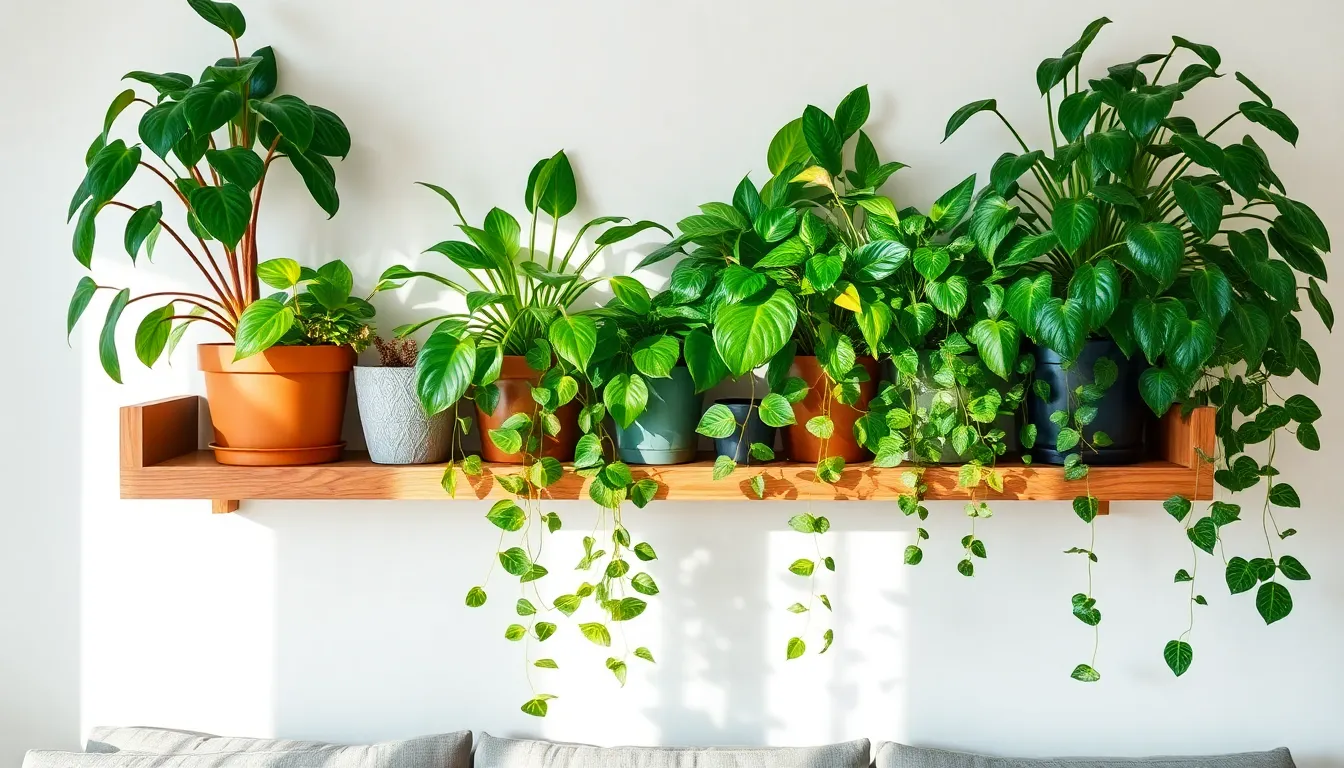
Choosing plants that match your shelf’s location and lighting conditions ensures long-term success with your floating garden display. We’ll guide you through the best plant categories that thrive on floating shelves while creating stunning visual impact.
Low-Light Tolerant Houseplants
ZZ Plants (Zamioculcas zamiifolia) top our list for dim corners since they’re incredibly low maintenance and actually prefer indirect light. These glossy-leafed beauties can survive weeks without water and still look pristine on your shelves.
Nerve Plants (Fittonia albivenis) bring intricate leaf patterns in pink, white, or green veining that catches the eye even in darker spaces. We love how their compact size fits perfectly on narrow shelves while adding sophisticated texture.
Prayer Plants (Maranta spp.) offer fascinating foliage that literally folds up at night, creating an ever-changing display on your shelves. Their tolerance for partial to low light makes them ideal for interior walls away from windows.
Rattlesnake Calathea (Calathea lancifolia) delivers striking spotted leaves in a compact form that won’t overwhelm smaller shelves. These plants actually prefer filtered light, making them perfect for spots where other plants might struggle.
Baby Tears (Soleirolia soleirolii) create a lush, carpet-like appearance that spills gently over shelf edges in low to partial light conditions. Their spreading growth habit fills empty spaces beautifully without requiring bright sunlight.
Trailing and Cascading Plant Varieties
Philodendrons with their classic heart-shaped leaves create elegant cascades that soften hard shelf lines while being remarkably easy to grow indoors. We recommend these for beginners since they’re forgiving and grow quickly to fill your display.
Dischidia Oiantha stands out for its stunning cascading foliage that creates dramatic vertical interest on floating shelves. This variety requires minimal care while delivering maximum visual impact as it trails downward.
Ivy varieties offer classic trailing beauty that adds movement and depth to your shelf arrangements. Spider Plants complement ivy perfectly with their arching leaves and occasional baby plantlets that dangle like natural ornaments.
These trailing options work especially well on higher shelves where their cascading growth can be fully appreciated without blocking walkways or other displays.
Compact Plants That Thrive in Small Spaces
Succulents and Air Plants excel on narrow floating shelves because they require minimal root space and water infrequently. Their architectural forms create modern, sculptural displays that complement contemporary shelf designs.
Lace Ferns fit beautifully in small nooks while requiring only indirect sunlight and minimal maintenance. We find these delicate plants perfect for adding soft texture without overwhelming limited shelf space.
Small ferns and mosses bring natural woodland vibes to tight spaces while staying compact throughout their growth. These plants add rich green texture and work particularly well grouped together on wider shelves.
Miniature varieties of popular houseplants often work better than full-sized versions since they maintain their proportions relative to your shelf dimensions while providing the same visual appeal.
Install Floating Shelves Safely for Plant Displays
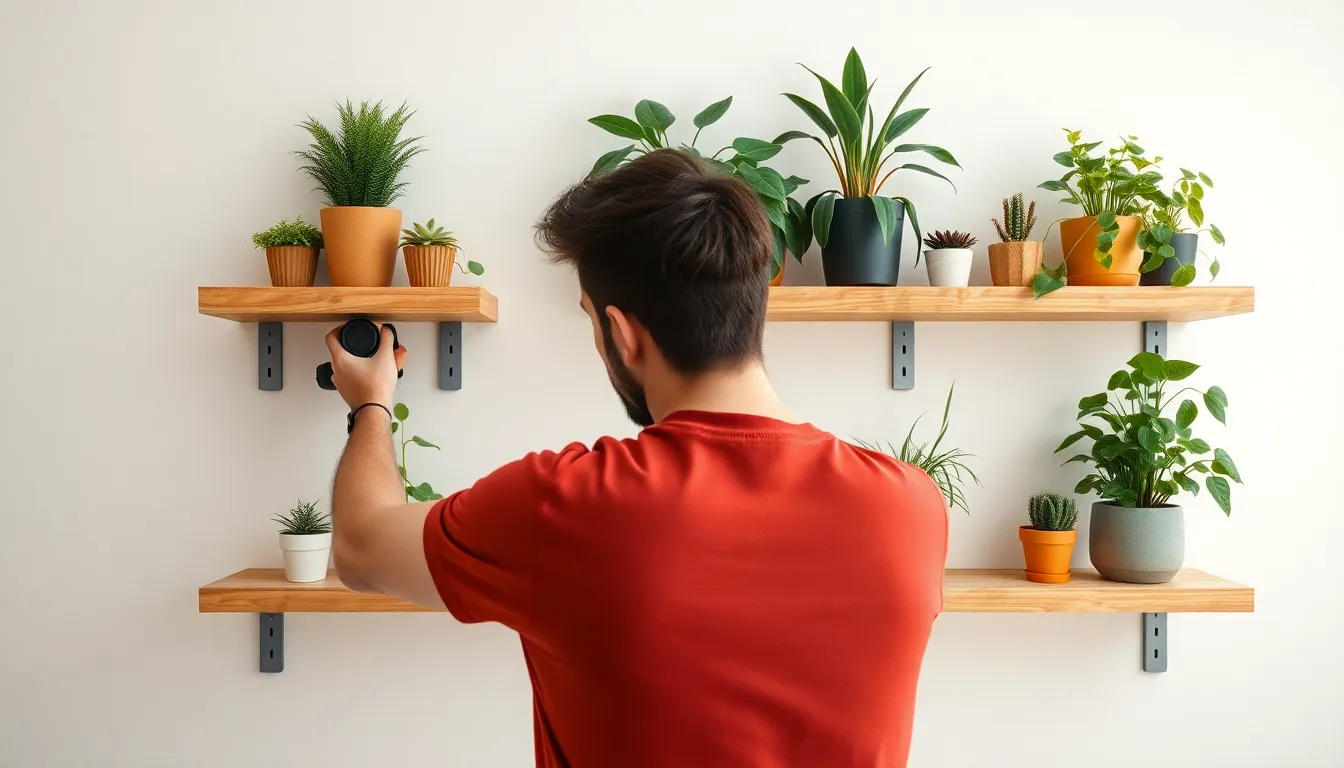
Now that we’ve chosen our plants and shelves, let’s ensure they’re installed correctly to support our green displays safely and securely.
Wall Stud Location and Mounting Hardware
Finding wall studs becomes crucial when installing floating shelves that’ll hold plant weight. We recommend using a stud finder to locate the structural supports behind your wall, as anchoring directly to studs provides the strength needed to support your plants safely.
Mark the stud positions with a pencil before drilling to ensure accurate placement. Drill pilot holes at these marked locations to prevent wood splitting and create clean entry points for your mounting hardware.
Install mounting brackets or T-brackets directly into the studs using appropriate screws and anchors. Secure attachment requires screws that penetrate at least 1.5 inches into the stud for optimal holding power.
Slide the shelf onto the bracket once everything’s properly secured. Verify that it’s level using a bubble level and test stability by gently pressing down before adding any plant weight.
Proper Height Placement for Plant Care
Position your floating shelves at eye level or slightly below for easy plant maintenance access. This height allows us to water, prune, and monitor our plants without straining or using step stools.
Consider the light requirements of your chosen plants when determining shelf placement. Place shelves near windows for light loving varieties, but avoid direct harsh sunlight that can scorch sensitive foliage.
Leave adequate clearance above each shelf to accommodate plant growth and ensure proper airflow circulation. Most houseplants need at least 12-18 inches of vertical space to thrive without feeling cramped.
Waterproofing and Drainage Answers
Protect your shelves and walls from water damage by applying waterproof finishes or sealants to wooden shelves before installation. This preventive measure extends shelf life and prevents water absorption that can cause warping or rot.
Place waterproof trays or saucers under each plant pot to catch excess water during watering sessions. These barriers prevent water from seeping onto shelf surfaces and eventually damaging your walls.
Consider using self watering planters or containers with built in drainage systems to minimize water overflow risks. These answers reduce maintenance while protecting your floating shelf investment.
Monitor watering frequency to avoid overwatering, which can lead to drainage problems and potential shelf damage. Allow plants to drain properly in their saucers before returning them to their display positions.
Design Stunning Plant Arrangements on Floating Shelves
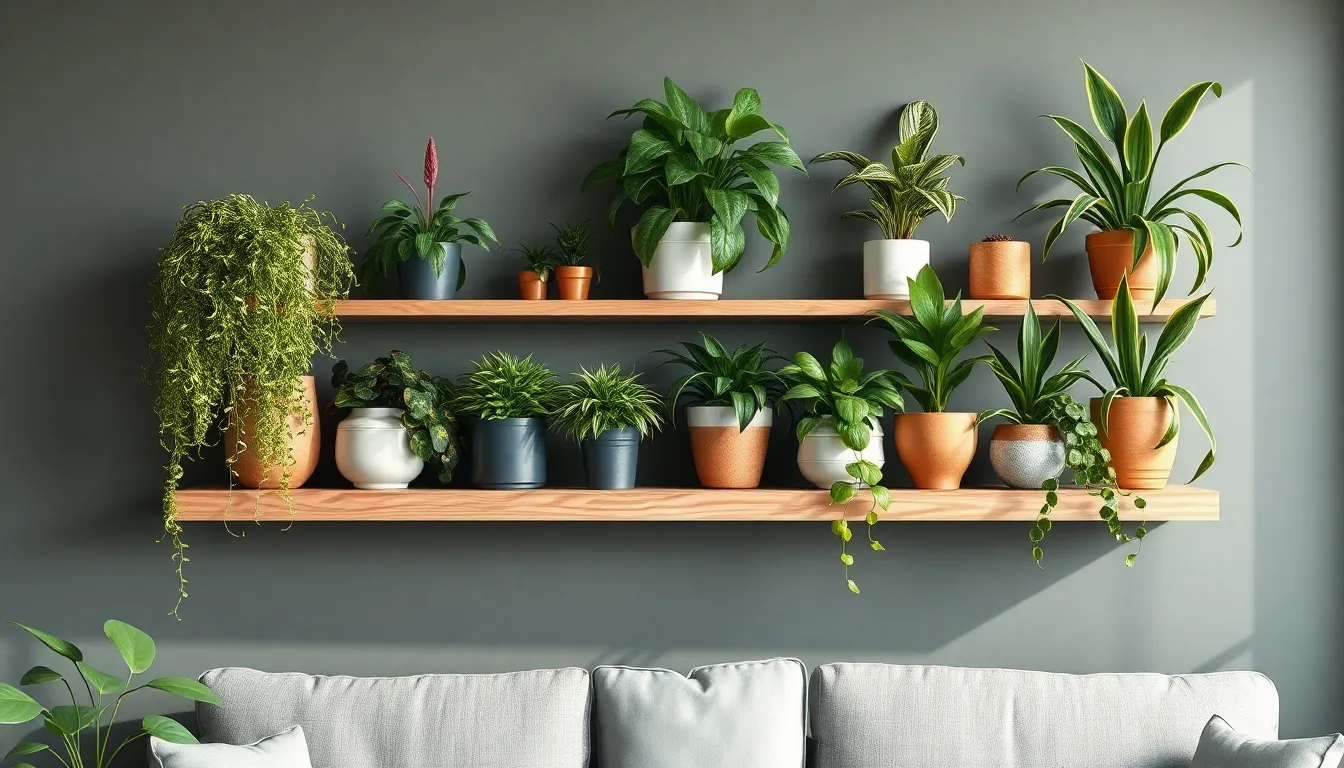
Creating eye-catching plant displays on floating shelves requires thoughtful planning and strategic arrangement techniques. We’ll show you how to transform your shelves into living art pieces that enhance any room’s aesthetic.
Creating Visual Balance and Symmetry
Staggering plants across your shelves creates natural visual flow rather than rigid uniformity. We recommend avoiding evenly spaced arrangements and instead grouping larger plants with smaller companions to achieve organic balance. Alternating trailing and upright plants throughout your display adds depth while maintaining harmony across the entire arrangement.
Symmetrical placement with textural variation produces the most pleasing results for focal wall displays. We suggest placing similar-sized plants on opposite ends of shelves while varying their leaf shapes and growth patterns between sides. This approach creates structured balance without appearing too formal or sterile.
Color coordination through plant selection and container choices unifies your entire floating shelf garden. We’ve found that choosing plants with complementary foliage colors alongside neutral or matching planters creates visual cohesion throughout multi-shelf arrangements.
Mixing Plant Sizes and Textures
Combining various leaf textures and plant sizes transforms basic shelf displays into ever-changing living sculptures. We recommend pairing trailing varieties like string of hearts or string of pearls with upright specimens such as snake plants or philodendrons to create compelling visual contrast.
Larger hanging plants positioned at shelf tops add dramatic vertical interest while allowing foliage to cascade downward. We’ve discovered that this technique softens harsh shelf edges and introduces natural movement into otherwise static displays.
Climbing greenery fills vertical spaces between shelves effectively when trained upward using discrete support systems. We suggest incorporating pothos or philodendron varieties that naturally climb to maximize your vertical growing space.
Tiered arrangements using multiple shelf levels help organize plants by size requirements while ensuring adequate light access for each specimen. We position taller plants on upper shelves and shorter varieties below to prevent shading issues.
Incorporating Decorative Planters and Containers
Varying planter materials across your display adds textural richness and visual interest to floating shelf arrangements. We recommend mixing ceramic, wood, and metal containers to create depth while maintaining cohesive color schemes that complement your room’s decor.
Custom floating shelves designed for plant displays accommodate exact container sizes and weight requirements better than standard options. We’ve found that handcrafted or custom-sized shelves provide personalized answers for unique plant collections and challenging wall spaces.
Wire or mesh shelf materials support plant health by allowing proper air circulation and humidity management around containers. We prefer these options for moisture-loving plants since mist and water can move freely without damaging shelf surfaces.
Decorative pots serving as focal points anchor your arrangements while reflecting your personal style preferences. We suggest selecting statement planters for key positions and simpler containers for supporting plants to create visual hierarchy throughout your display.
Maintain Your Floating Shelf Plant Display
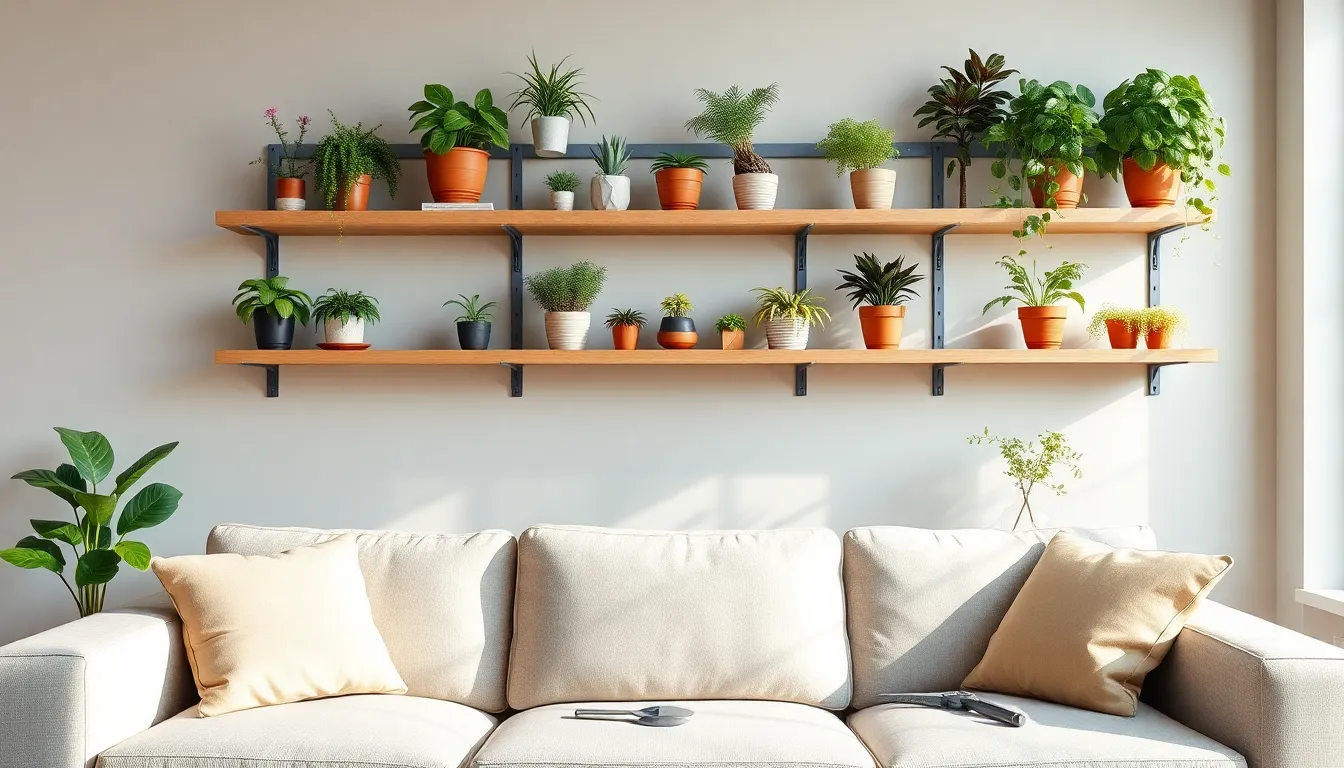
Successful floating shelf plant displays require consistent care routines that protect both your plants and your walls. We’ll guide you through essential maintenance practices that keep your green displays thriving while preventing costly damage to your home.
Watering Techniques to Prevent Wall Damage
Place saucers or small plates under each plant to catch excess water and prevent drips from reaching your shelves or walls. Water management becomes critical when dealing with elevated plant displays, as runoff can cause important damage over time.
Consider using absorbent mats or long trays when shelf space limits your saucer options. These alternatives provide effective water collection while maximizing your display area for plants.
Choose pots without drainage holes to eliminate water runoff entirely, but monitor soil moisture carefully to prevent root damage from stagnant water. This approach works particularly well for plants that prefer consistent but not waterlogged conditions.
Remove plants to your sink for thorough watering sessions, then return them to their shelf positions once excess water drains away. This method ensures complete hydration while eliminating any risk of wall or shelf damage.
Allow soil to dry between watering sessions to prevent overwatering, which can lead to both plant health issues and increased water runoff. Establishing this routine protects your investment in both plants and home improvements.
Pruning and Plant Care Access
Position floating shelves at heights that allow easy access for regular pruning and maintenance tasks. Accessibility determines how well you can care for your plants long term, directly impacting their health and appearance.
Maintain adequate space around each shelf to accommodate pruning tools and comfortable hand positioning. This clearance becomes essential when dealing with trailing plants that require regular trimming to maintain their shape.
Schedule regular pruning sessions to promote healthy growth and prevent overcrowding on your shelves. Consistent trimming encourages new growth while maintaining the aesthetic balance of your display.
Trim dead or yellowing leaves immediately to prevent disease spread and maintain visual appeal. Quick removal of damaged foliage keeps your floating shelf garden looking fresh and professional.
Keep your pruning tools clean and sharp to make precise cuts that heal quickly and reduce plant stress. Proper tool maintenance ensures each pruning session benefits rather than harms your plants.
Rotating Plants for Even Growth
Rotate each plant every few days to ensure all sides receive equal light exposure and prevent uneven growth patterns. This simple practice prevents one side from becoming leggy while the other side withers from insufficient sunlight.
Establish a rotation routine during your regular watering schedule to maintain consistency without adding extra maintenance tasks. Combining these activities saves time while ensuring neither task gets forgotten.
Turn plants a quarter rotation each time to gradually expose all sides to available light sources. This systematic approach ensures balanced growth without shocking the plants with sudden environmental changes.
Monitor plant growth patterns to identify which specimens need more frequent rotation based on their light requirements. Some plants show uneven growth more quickly than others, requiring adjusted rotation schedules.
Create a simple tracking system to remember which direction you last rotated each plant, ensuring systematic coverage over time. Consistent rotation patterns prevent accidentally favoring one side over another during maintenance sessions.
Style Different Rooms with Floating Shelves and Plants
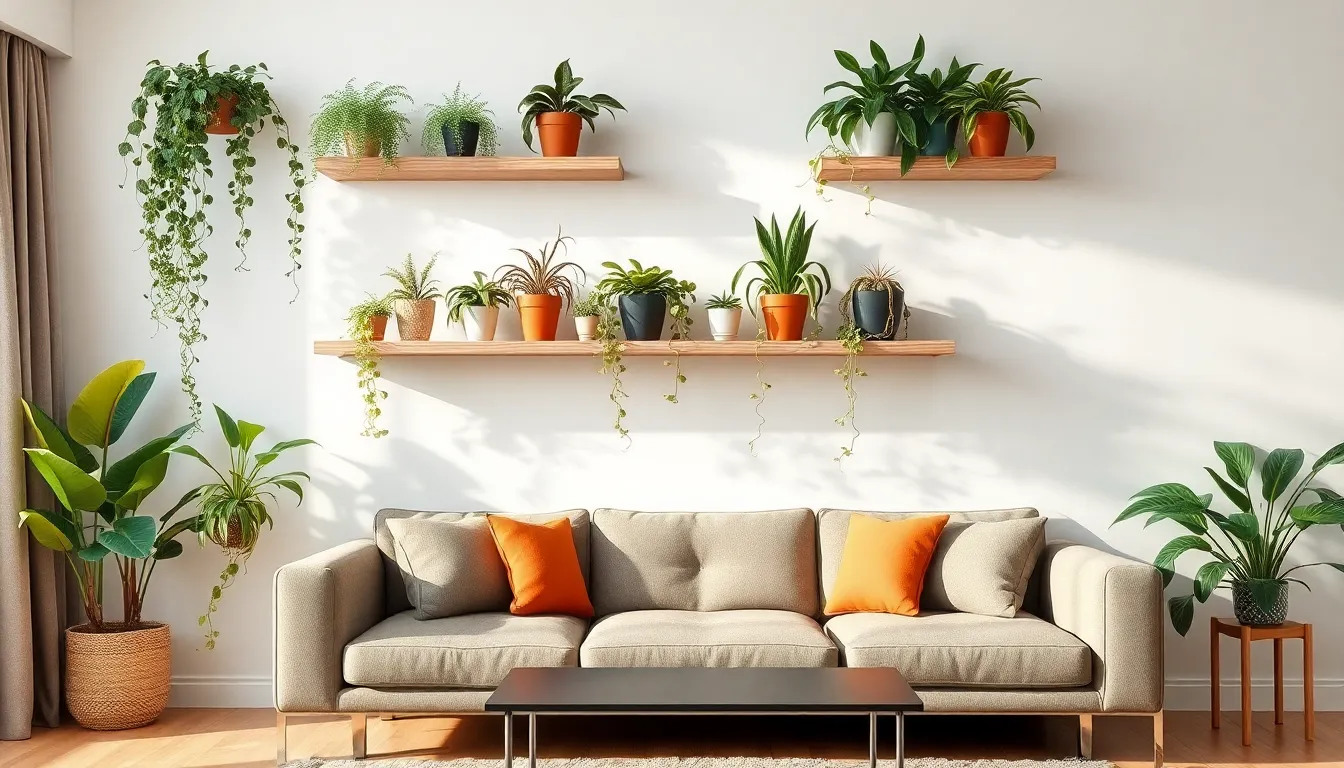
Each room in your home offers unique opportunities to showcase floating shelves with plants. We’ll help you maximize the natural conditions and design potential of your living spaces.
Living Room Plant Shelf Arrangements
Transform your living room into a green oasis by arranging floating shelves with plants that blend different textures, colors, and growth habits. Position shelves in medium to bright indirect light areas where plants can thrive while creating visual interest throughout the space.
Mix trailing plants with upright varieties to create ever-changing displays that add depth to your walls. String of hearts and string of pearls cascade beautifully over shelf edges, while philodendrons and hoyas provide structured vertical elements that balance the composition.
Stagger plants at different heights across multiple shelves to prevent overcrowding and allow each plant to receive adequate light. This arrangement technique maximizes your wall space for plant collections while ensuring every plant has room to grow and flourish.
Create visual movement by allowing some trailing plants to drape naturally over the edges of your floating shelves. The cascading effect draws the eye upward and makes your living room feel more spacious and inviting.
Kitchen Herb Garden Floating Displays
Grow fresh herbs on floating shelves positioned near natural light sources in your kitchen for easy access during cooking. Basil, rosemary, thyme, and parsley thrive in small pots or planters that fit perfectly on floating shelves without taking up valuable counter space.
Choose rustic or modern floating shelves that complement your kitchen decor while serving the functional purpose of an indoor herb garden. The style flexibility allows you to maintain your kitchen’s aesthetic while adding practical greenery to your cooking space.
Keep countertops clear by utilizing vertical wall space for your herb collection. Floating shelves provide the perfect solution for maintaining a small indoor herb garden without sacrificing prep space or creating clutter in your kitchen.
Access fresh herbs easily during meal preparation when they’re displayed at eye level on floating shelves. This convenient placement encourages regular use and harvesting, which actually promotes healthier plant growth.
Bathroom Humidity Loving Plant Setups
Take advantage of naturally higher humidity in bathrooms by displaying tropical plants on floating shelves. Ferns, spider plants, and orchids thrive in these moisture rich environments that mimic their natural habitats.
Install wire or slatted floating shelves that allow proper air circulation and water drainage around your plants. This design prevents water from pooling and maintains the healthy growing conditions that humidity loving plants require.
Add grow lights or position shelves in areas with indirect light to enhance plant growth in windowless bathrooms. Supplemental lighting ensures your tropical plants receive the energy they need to flourish in these naturally humid spaces.
Place a humidifier near your shelves to further benefit moisture loving plants and create a spa like atmosphere in your bathroom. This additional humidity boost helps plants like ferns and orchids maintain their lush, vibrant appearance.
| Room | Best Plants | Lighting Needs | Special Features |
|---|---|---|---|
| Living Room | Trailing and upright varieties | Medium to bright indirect light | Staggered heights, mixed textures |
| Kitchen | Fresh herbs (basil, rosemary, thyme) | Natural light sources | Easy access, clear countertops |
| Bathroom | Tropical plants (ferns, orchids) | Indirect light or grow lights | Wire shelves, humidity benefits |
Troubleshoot Common Floating Shelf Plant Problems
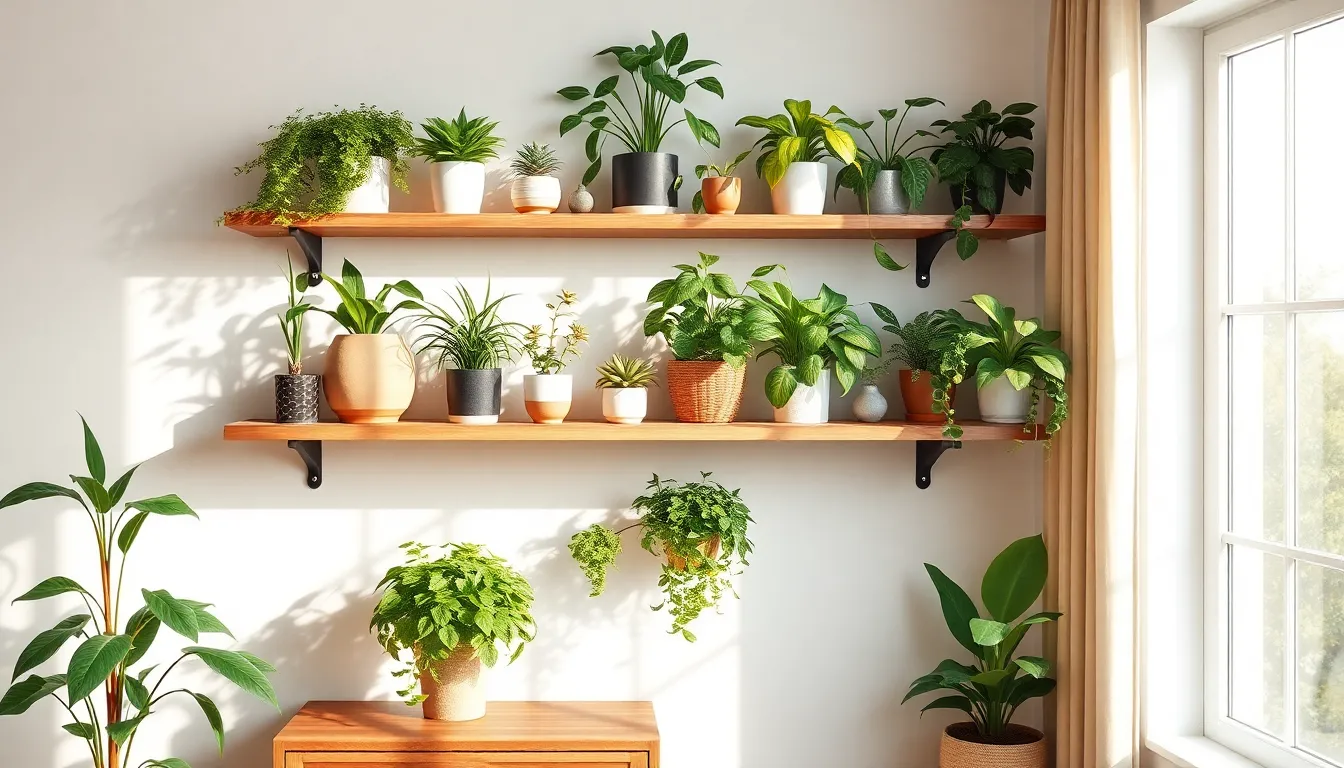
Even the most carefully planned floating shelf plant displays can encounter challenges that threaten both plant health and structural integrity. We’ll address the most common issues and provide proven answers to keep your green displays thriving.
Preventing Water Damage to Walls and Shelves
Water damage represents the most important threat to both your floating shelves and wall surfaces. Moisture from regular watering can warp wooden shelves, damage paint, and even compromise wallpaper adhesion over time.
Waterproof liners serve as your first line of defense against moisture damage. Place these protective barriers under every plant pot to catch excess water before it reaches your shelf surface. Rubber mats, plastic trays, and cork coasters all provide effective moisture protection.
Drainage trays paired with your plant pots create a double barrier system. Select pots with built-in drainage holes and pair them with matching saucers to contain any water overflow. This combination prevents direct contact between wet soil and your shelf materials.
Direct placement of plants on shelves without protection leads to inevitable damage. Always use some form of barrier between your plants and shelf surface, whether it’s a decorative tray, waterproof mat, or drainage system.
Dealing with Overwatering and Drainage Issues
Overwatering kills more houseplants than any other factor and creates additional problems for floating shelf installations. Poor drainage compounds these issues by allowing water to pool and potentially overflow onto your shelves.
Proper pot selection starts with choosing containers that include drainage holes at the bottom. Avoid decorative pots without drainage unless you’re using them as outer cachepots with properly draining inner containers.
Self-watering planters eliminate guesswork and reduce the risk of overwatering. These systems regulate moisture levels automatically while containing excess water within the planter itself.
Regular drainage maintenance requires emptying saucers and trays after each watering session. Allow plants to drain completely before returning them to their shelf positions to prevent standing water accumulation.
Watering location matters more than many people realize. Remove plants from their shelf positions for thorough watering sessions, allowing them to drain fully before replacing them in their display locations.
Managing Plant Growth and Overcrowding
Plants on floating shelves can quickly outgrow their allocated space, leading to overcrowding that creates health problems and aesthetic issues. Unchecked growth also increases weight loads on your mounting system.
Size-appropriate plant selection prevents many overcrowding issues before they start. Choose plants that match your available shelf dimensions and expected mature size rather than hoping to control growth through constant pruning.
Regular pruning maintains both plant health and visual appeal. Trim back excessive growth every few weeks to keep plants within their designated spaces and encourage fuller, more compact growth patterns.
Plant rotation ensures even light exposure and prevents plants from growing toward light sources in unbalanced ways. Rotate each plant a quarter turn weekly to promote symmetrical growth and prevent leaning.
Spacing guidelines recommend leaving at least 6 inches between plants to ensure adequate airflow. Poor air circulation promotes fungal diseases and pest problems that can quickly spread throughout your entire display.
Weight monitoring becomes crucial as plants grow larger and heavier. Regularly assess whether your shelf system can continue supporting the increased load, and consider redistributing plants if weight becomes excessive.
Conclusion
We’ve shown you how floating shelves with plants can transform any room into a vibrant living space. With the right shelf selection proper installation and thoughtful plant choices you’ll create displays that are both beautiful and functional.
Remember that success comes from matching your plants to their environment and maintaining consistent care routines. Whether you’re starting with low-light tolerant varieties or cascading plants the key is choosing what works best for your space and lifestyle.
Your floating shelf plant displays will continue to evolve as your plants grow and your confidence increases. Start small experiment with different arrangements and enjoy watching your green oasis flourish on your walls.
Frequently Asked Questions
What are the main benefits of using floating shelves for plant displays?
Floating shelves provide display space without taking up valuable floor area, making them perfect for small living spaces. They create vertical growing opportunities while maintaining a clean, minimalist aesthetic. These shelves can transform any room into a green oasis while keeping surfaces clutter-free and maximizing your available space for both plants and daily activities.
Do I need advanced DIY skills to install floating shelves for plants?
No, you don’t need extensive DIY experience. The article provides tested plant-and-shelf combinations that are beginner-friendly. Basic installation involves locating wall studs, drilling pilot holes, and using appropriate mounting hardware. Following the step-by-step guidance ensures secure installation without requiring professional carpentry skills or advanced tools.
How much weight should floating shelves support for plant displays?
Choose shelves rated for at least 20% more than your heaviest plant’s total weight, including the pot and soil. This safety margin accounts for water weight and plant growth over time. Proper installation into wall studs is essential for supporting plant weight safely, preventing shelf failure and potential wall damage.
What materials work best for plant display shelves?
Sealed hardwoods offer excellent moisture resistance, while metal shelves provide superior durability and weight capacity. Tempered glass creates a minimalist aesthetic but requires careful weight consideration. Choose materials that can withstand humidity and occasional water exposure while complementing your room’s existing décor and style preferences.
Which plants work best for low-light floating shelf displays?
ZZ Plants, Nerve Plants, Prayer Plants, Rattlesnake Calathea, and Baby Tears thrive in dim conditions. These low-light tolerant houseplants maintain their health and appearance even in areas with limited natural sunlight, making them perfect for interior walls, hallways, or rooms with north-facing windows.
How do I prevent water damage to walls and shelves?
Use waterproof liners and drainage trays under all plants to catch excess water. Apply protective finishes to wooden shelves and monitor watering frequency carefully. Remove plants for thorough watering sessions when possible, and use absorbent mats to protect surfaces from moisture damage and prevent wall staining.
What’s the ideal spacing between floating shelves for plants?
Allow adequate vertical space for plant growth, typically 12-18 inches between shelves for most houseplants. Consider mature plant size, trailing growth patterns, and light access requirements. Proper spacing ensures plants don’t overcrowd each other while allowing easy access for maintenance and creating visually balanced arrangements.
How often should I rotate plants on floating shelves?
Rotate plants weekly or bi-weekly to ensure even light exposure and prevent uneven growth patterns. Establish a consistent routine that includes both watering and rotation schedules. Regular rotation promotes balanced growth, prevents plants from leaning toward light sources, and maintains attractive, symmetrical plant displays.
Can I use floating shelves for herb gardens in the kitchen?
Yes, floating shelves work excellently for indoor herb gardens, providing easy access while keeping countertops clear. Choose compact herbs like basil, mint, and parsley that thrive in containers. Ensure adequate light exposure near windows or supplement with grow lights for optimal herb growth and continuous harvesting.
What should I do if my plants outgrow their shelf space?
Regular pruning helps manage plant size and promotes healthy growth. Consider transplanting to larger spaces or selecting more compact varieties initially. Monitor plant growth regularly and adjust arrangements as needed. Ensure adequate spacing for airflow and consider the shelf’s weight capacity as plants mature and become heavier.

